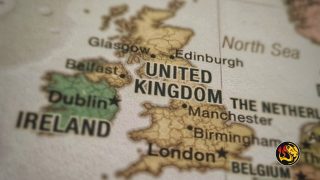British Military Thinktank Warns Of Dangerous Decade

By Stefan J. Bos, Chief International Correspondent Worthy News
LONDON/JERUSALEM/BUDAPEST (Worthy News) – An influential British military think-tank warns that tensions around the world signal “what is likely to be a more dangerous decade.”
The International Institute for Strategic Studies (IISS) noted in its annual Military Balance report that “the current military-security situation heralds what is likely to be a more dangerous decade, characterized by the brazen application by some of the military power to pursue claims.”
The report comes amid preparations in European countries for a war with Russia following its invasion of Ukraine.
Additionally, the Israel-Hamas war, Iran-backed attacks, China’s military maneuvers around Taiwan, and North Korea’s nuclear arms program have also raised concerns.
The IISS also mentioned the impact of Azerbaijan’s takeover of the Nagorno-Karabakh region last year, which forced more than 100,000 mainly Christian Armenians to leave their homes, as well as coups in Niger and Gabon.
“The deteriorating security environment is exemplified by mounting conflicts – such as the Hamas–Israel war, Russia’s continued aggression against Ukraine, and Azerbaijan’s takeover of the Nagorno-Karabakh region; coups in Niger and Gabon,” it noted.
“China’s more assertive maneuvers around Taiwan, in the South China Sea and elsewhere; and attacks on critical national infrastructure, including a gas pipeline and data cables in the Baltic Sea,” also added to global insecurity.
SUPPLYING MISSILES
The report also said Iran’s supply of missiles to Houthi rebels in Yemen and drones to Russia highlighted Tehran’s growing role in conflict zones.
Elsewhere, unrest related to the Gaza conflict risked spreading, having already affected Yemen, the Red Sea, Lebanon, Iraq, and Syria, warned Ben Barry, a land warfare expert at IISS and a retired British army brigadier.
The Military Balance 2024 report noted these battles and the “era of insecurity” reset the global defense-industrial landscape, with the United States and Europe ramping up production of missiles and ammunition “after decades of underinvestment.”
The global warfare requires higher defense budgets and equipment inventories, including for Russia, the group stressed.
“Russia has lost over 2,900 main battle tanks since launching its full-scale war on Ukraine, about as many as it had in active inventory at the outset of the operation. Moscow has been able to trade quality for quantity though, by pulling thousands of older tanks out of storage at a rate that may, at times, have reached 90 tanks per month,” said the IISS in introducing the report reviewed by Worthy News.
“Russia’s stored equipment inventories mean Moscow could potentially sustain around three more years of heavy losses and replenish tanks from stocks, even if at lower technical standard, irrespective of its ability to produce new equipment,” it explained.
However, Ukraine also “suffered heavy losses, though Western replenishments have allowed it to broadly sustain its inventory size while upgrading equipment quality. The situation underscored a growing feeling of a stalemate in the fighting that may persist through 2024,” the IISS wrote.
PROVIDING WEAPONS
Bastian Giegerich, the IISS director general, cautioned that “Western governments find themselves once again in a position where they must decide whether to furnish Kyiv with enough weapons to deliver a decisive blow or merely enough not to lose.”
It is, therefore, “incredibly vital” that the US passes a package releasing $60 billion of funding for Ukraine’s war effort, argued Fenella McGerty, IISS defense economics specialist.
The U.S. Senate approved an aid bill on Tuesday, but the legislation faces opposition from the Republican majority in the U.S. House of Representatives.
Failure to pass the bill “would require a complete rethink about the goals and tactics used because that funding would be very difficult for Europe to make up,” McGerty warned.
Driven in part by NATO’s response to Russia’s invasion of Ukraine, global military spending grew by 9 percent in 2022 to reach a record $2.2 trillion, noted the report.
Russia’s “aggression spurred European countries to boost defense spending” and has “strengthened NATO, with Finland adding combat power and experience in societal-resilience plans” as it joined the alliance.
NATO member states’ defense spending, dominated by the United States, has risen to about 50 percent of the global total, according to IISS data. They, along with China, Russia, and India, spend over 70 percent of global military spending on their militaries.
OUTLOOK DETERIORATING
“The security outlook has definitely deteriorated, and we’re seeing countries respond to that,” said McGerty.
Republican presidential hopeful Donald Trump said on Saturday he had told one NATO member’s leader that he would “encourage” Russia to “do whatever the hell they want” to that country if it had not met its NATO financial obligations.
“You got to pay. You got to pay your bills,” Trump recounted at a campaign rally.
Only 10 members of the security alliance met the group’s target of spending two percent of gross domestic product on defense, although 19 of them increased spending last year, according to IISS figures.
“Russia’s actions have reinvigorated NATO, with Finland completing its rapid alliance accession process in April 2023,” the report noted.
Sweden is also seeking membership, with Hungary being the last holdout to ratify its entry into the alliance.
“Russia’s border with NATO members is now more than 1,300 kilometers longer,” the IISS concluded, something Russian President Vladimir Putin had tried to prevent.
If you are interested in articles produced by Worthy News, please check out our FREE sydication service available to churches or online Christian ministries. To find out more, visit Worthy Plugins.
